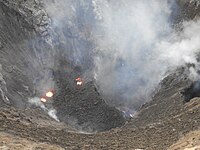
Photo from wikipedia
Abstract The Argentinean side of the Andean North Patagonia is drained by several fluvio-lacustrine systems flowing eastwards from their headwaters at the Andes mountains towards large glacial lakes. These watersheds… Click to show full abstract
Abstract The Argentinean side of the Andean North Patagonia is drained by several fluvio-lacustrine systems flowing eastwards from their headwaters at the Andes mountains towards large glacial lakes. These watersheds are recurrently affected by the deposition of tephra erupted from the many active Andean volcanos located in the Southern Volcanic Zone. This research focusses on two fluvial systems (Pireco and Totoral, PT) located in Nahuel Huapi National Park, which were severely impacted by the Cordon Caulle 2011 eruption (CC2011). We investigate particularly the resedimentation of pyroclastic materials on their lacustrine deltas and its potential implications considering 1) the deltas morphology and 2) mass-wasting processes developing at the delta fronts. Original tephra fall deposits were registered at Nahuel Huapi National Park in 2011. Based on the isopach map, we performed a GIS-based volume estimation of the deposit for the studied watersheds. Delta plain progradation from 2011 to 2017 was analyzed from satellite images. We studied the temporal evolution of the subaqueous morphology and mass-wasting processes at the delta fronts using high resolution bathymetric grids registered in 2011, 2014 and 2017. During June 2011 the studied watersheds received a tephra input of ~72 x 106m3. The significant progradation experienced by both deltas especially during the first month of the eruption was favored by 1) abundant precipitation at the watersheds concomitant to heavy tephra deposition and 2) the pre-existing subaqueous morphology characterized by a wide, shallow “terrace” bordering PT delta plains. About six years after the beginning of CC2011, 6% of the tephra fallen over the entire basins had been resedimented at the delta environments (terrace and delta front), totalizing ~3 x 106t. Evidence of pre-eruption and/or co-eruptive mass-wasting processes occurring at PT delta fronts was found on November 2011. Up to 30-m thick pyroclastic deposits were accumulated at PT delta fronts since November 2011, burying mass-wasting features at the upper delta fronts. A suspended-sediment collector installed at the prodelta in 2012 detected hyperpycnal currents transporting pyroclastic materials. These currents probably explain the development of mass-movements at high depths, such as the one that displaced and filled up the bottom sediment trap. This frontally-confined landslide initiated at a depth of >60 m and involved tephra and organic materials deposited at the lower part of Totoral delta front. Because of their recent deposition and loose consolidation, we propose that fresh tephra deposits at PT delta fronts could become particularly unstable and represent a potential hazard to failure, especially if a strong earthquake affects the study area in the next years. A landslide-induced tsunami wave generated at these deltas would impact rural settlements located along the coasts of Brazo Rincon and probably reach the coastal city of Villa La Angostura.
Journal Title: Geomorphology
Year Published: 2019
Link to full text (if available)
Share on Social Media: Sign Up to like & get
recommendations!